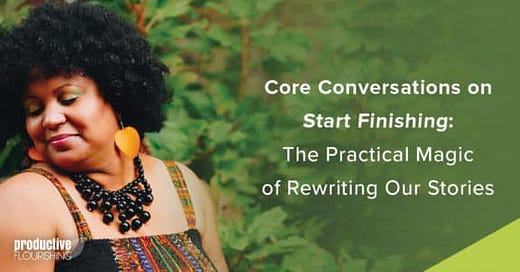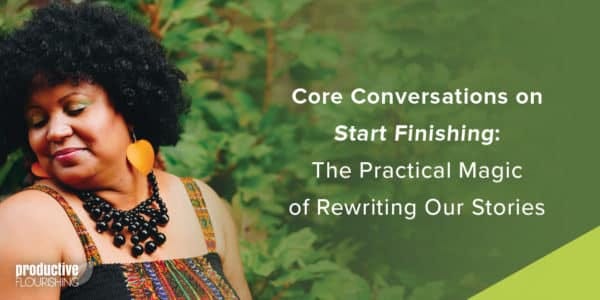Core Conversations on Start Finishing: The Practical Magic of Rewriting Our Stories
How to rewrite the stories of Me, Time, Success, and Us on the way to our best work
Editor’s Note: This is a continuation of our core conversations on Charlie’s book Start Finishing. In our last conversation, Shahrzad Arasteh talked about reaching your “what’s next.” In today’s conversation, Kerra Bolton talks about the practical magic of rewriting the stories we tell ourselves.
Charlie Gilkey is a wizard.
I thought Charlie wrote Start Finishing: How to Go from Idea to Done to help me cross items off my to-do list so that I can finally get to the dream projects that have haunted my New Year’s resolutions for decades.
Yes and no.
Charlie is masterful at helping readers clarify their goals and align their lives to support their best work. Dig deeper, however, and you’ll find that Start Finishing is a book whose goal is nothing short of individual and community transformation.
“You can rewrite the stories that keep you from being your best self,” Charlie says. “You can change the way you show up, how you plan, and how you respond when things inevitably get rough.”
The idea of rewriting our stories resonates with me as a writer, filmmaker, and social justice advocate. I am currently working on a film in which I learn to swim as a means of challenging the epigenetic trauma many black people have of swimming and the ocean. (Epigenetics in this case refers to the bodily trauma some black people may have inherited as a result of slavery.)
Nevertheless, the aims of Start Finishing and my film are the same — we can rewrite the stories of our lives when we align our deepest truths with intention, awareness, boundaries, courage, and discipline. (Tweet this.)
To accomplish this, there are three stories we must rewrite along the way to do our best work: the stories of Me, Time, and Success.
The Story of Me
The “Story of Me” is the head trash we carry about who we are, what we do, and how other people’s actions affect who we are and what we do. Head trash, as Charlie explains it, is the accumulation of stories we have carried since childhood or acquired as adults “based on our own personal experiences, histories, and contexts.”
Rewriting the “Story of Me” gives us an accurate basis for our Start Finishing journey. If you don’t know who you truly are underneath the stories you’ve made up about yourself, how will you know what you want, what projects comprise your best work, and what resources you’ll need to achieve your goals?
Taking out the head trash is a good place to start. This can be as simple as leading with your curiosity. Asking if a story is true pulls us out of the past and into the present. Asking ourselves about other possibilities also nudges us toward a better future.
For me, race and racism comprise the ginormous and stinking landfills of head trash. Both have defined my self-esteem, life choices, education, quality of healthcare, housing, and safety in public spaces.
Living abroad has helped me to take out my head trash because while I still face many challenges, confronting racism daily isn’t one of them. I now have the time and (head) space to ask critical questions about my internalized racism and examine whether alternative pathways are possible.
Because of that curiosity, I am currently doing my best work. Rewriting the story of my relationship to race and racism in the United States is leading me toward a grand adventure — one of purpose, connection, and possibility.
The Story of Time
We often claim we don’t have time to do our best work. Another story, however, may be at play. To rewrite it, we need to discover the “true” story and develop the courage to set boundaries and ask for help when we need it.
Charlie helps with that rewriting by offering practical strategies to shape time in the form of chunking, linking, and sequencing. He defines “chunking” as “splitting projects into coherent, doable parts.” Linking “joins chunks together so that they hang together.” Sequencing is “linking chunks together into logical order in space and time.”
Practicing chunking, linking, and sequencing compels us to confront two things: the chasm we imagined and the real ways we spend our time. The practice also requires us to be honest about how long a task or series of tasks will take.
Armed with such information, we can gauge our priorities and rewrite the story of time. Maybe you haven’t finished your book proposal as quickly as you would like not because there isn’t enough time, but because you need help from your siblings to help care for aging parents. Maybe you haven’t practiced your speech for an upcoming industry event because you need to negotiate equitable parenting responsibilities in the evenings. Whatever the reason for how we use (or misuse) time, gaining awareness of it is the first step toward changing our narrative.
The Story of Success
Sometimes we don’t do our best work because our projects and ideas are rooted in old stories of success. Chapter Three of Start Finishing addresses this idea. It is one of my favorite chapters because it provides a blueprint to rewrite the “Story of Success.”
We don’t complete projects because we’re trying to achieve someone else’s definition of success. For example, a friend failed the required exams to become a tax accountant three times, because getting a corporate gig was his parents’ definition of success. But he gained a fabulous (and lucrative) career as a movie character actor when he decided to pursue what mattered most to him.
You must rewrite the “Story of Success” so that it resonates with the person you are now — not the person you were, or the person you would like to become. That’s where Charlie’s process of “letting go to trade up” comes in. Freeing ourselves from work that weighs us down allows us to pursue the work that lights us up.
Asking whether a project is a “should” or reflects other people’s priorities anchors us in the present. Aligning our best work with “something that frustrates, annoys, angers, inspires, nourishes, or calls” permits us to nimbly respond to the most urgent demands on our time. When we “let go to trade up,” our work becomes a call-and-response relationship with the world rather than something we use to escape it.
Today, we live in perilous, politically divisive times that threaten to undermine democracy, civility, justice, and equality. Each of us must do our best work in spite of — or in response to — the times in which we live. And we don’t do that difficult work in isolation.
The Story of Us
As we struggle with our own projects and work, we may feel like we’re working alone.
That’s not true.
Our individual best work is like a tributary of a river. Each feeds into a larger body of water until our work, together, becomes as vital and vast as the ocean.
Charlie’s work, your work, and my work are all flowing into the “Story of Us.” How we write that story is up to us, with each day offering us a fresh opportunity to try again.
The “Story of Us” is a story of practical magic because the ordinary moments of our day can be transformed into the building blocks of a new story — and a new future.
Want more information? Start Finishing, the book that kicked off all of these Core Conversations, is your deeper dive into all aspects of how to turn your ideas into projects, and how to start finishing your best work.





